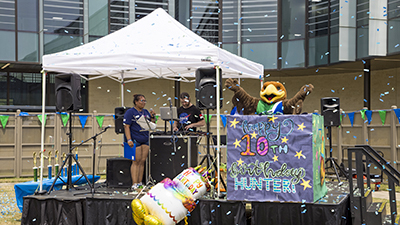The Master of Arts in Digital Media Studies is designed to provide students with the necessary tools and skills to thrive as creative professionals in the ever-evolving industry of digital media production. The degree responds to a cultural shift toward media convergence and emphasizes the importance of adaptability and embracing constant change and innovation. It combines strategic communication and business skills with production and design competence in the areas of photography, video, graphic design, gaming and software programming.
The program rests profoundly on three pillars:
- Creation and completion of hands-on industry-standard digital media projects;
- Extensive training in relevant and industry-standard communication skills, both written and spoken;
- Strong focus on conceptual and analytical skills, both visual and text-based, as well as technical skills.
The degree also emphasizes teamwork and network building. Students will not only graduate with an industry-relevant production portfolio but also with the network in place to demonstrate readiness for a career in the field.
The Digital Media Studies degree requires 36 hours of study. Students are required to take nine hours of Core Curriculum, courses, six hours of courses in Theoretical Foundations and 12 hours of courses Practical Applications in design and production. Students then select three additional hours in the area that most interests them. The course work is followed by a six-hour capstone experience in the form of a master’s project, master’s thesis, graduate internship, or comprehensive examination. Students are required to make a “B-” or better in all courses counting toward the degree and maintain a 3.00 or better GPA.
Admission
Students must have a GPA of 3.00 or better or have met the HSH admission GRE requirement to be accepted into the program. To be considered, students need to submit a production portfolio accompanied by a Statement of Purpose. The portfolio (for guidelines see below) should demonstrate significant experience in the field. The Statement of Purpose should clearly define the student’s goal with this degree and outline how the degree builds on the student’s previous experience and education in the field. If the selection committee deems the student’s experience and skills in the field as not sufficient students maybe provisionally accepted into the program, but will be required to complete especially recommended preparation courses within the first two semesters. Students may take the core classes (listed below) in conjunction with these recommended preparatory prerequisites but may not progress to further coursework until these prerequisites are completed.
Portfolio Guidelines
All portfolio pieces must be accessible online. We do not accept physical objects such as slides or CDs. If passwords are necessary to access the pieces, it is the student’s responsibility to communicate them. The committee will not reach out if pieces are not readily accessible. No more than 20 individual pieces should be submitted. The applicant must make clear his or her involvement in the production of each piece. Examples for successful portfolio pieces are written strategic or creative writing materials, graphic design examples, a 15-minute short film documentary, a series of digitally prepared photographs with a theme, a website, an app or a game. The most important function of the portfolio is to convince the selection committee that the intentions outlined in the Statement of Purpose may be achieved based on the student’s existing experience and skills.
Applications are accepted for review twice a year, from January 15-April 15 and from August 15-October 31. Admission decisions for fall are usually made by the end of April and for spring by the end of November.
Equipment and Software
The university provides on-campus labs equipped with computers and the software needed for coursework. Students who wish to work from home may need to purchase equipment and software. A DSLR camera and a computer are highly recommended for students concentrating in Production Design.









 Return to:
Return to: